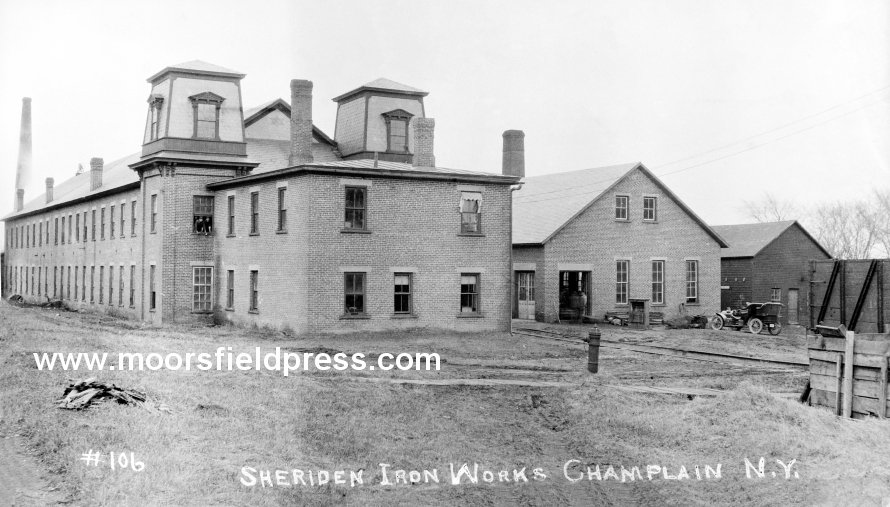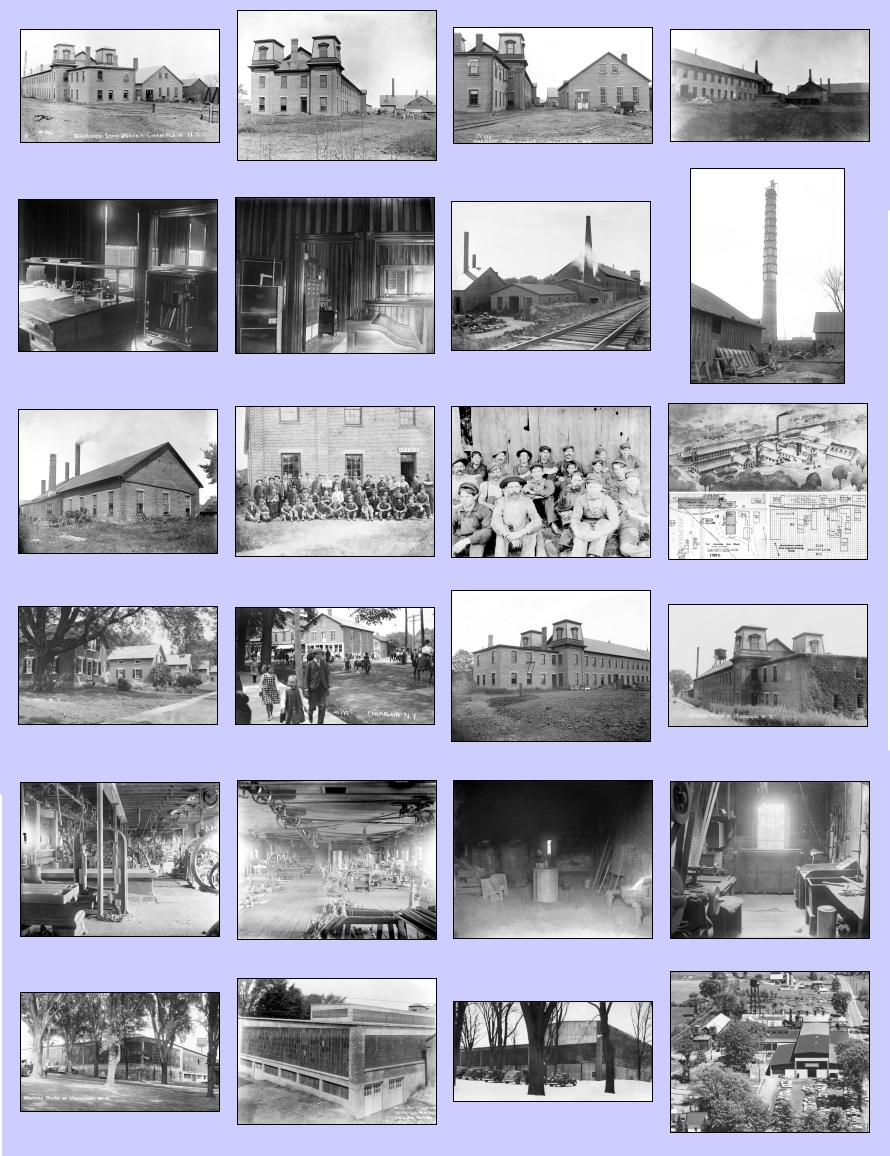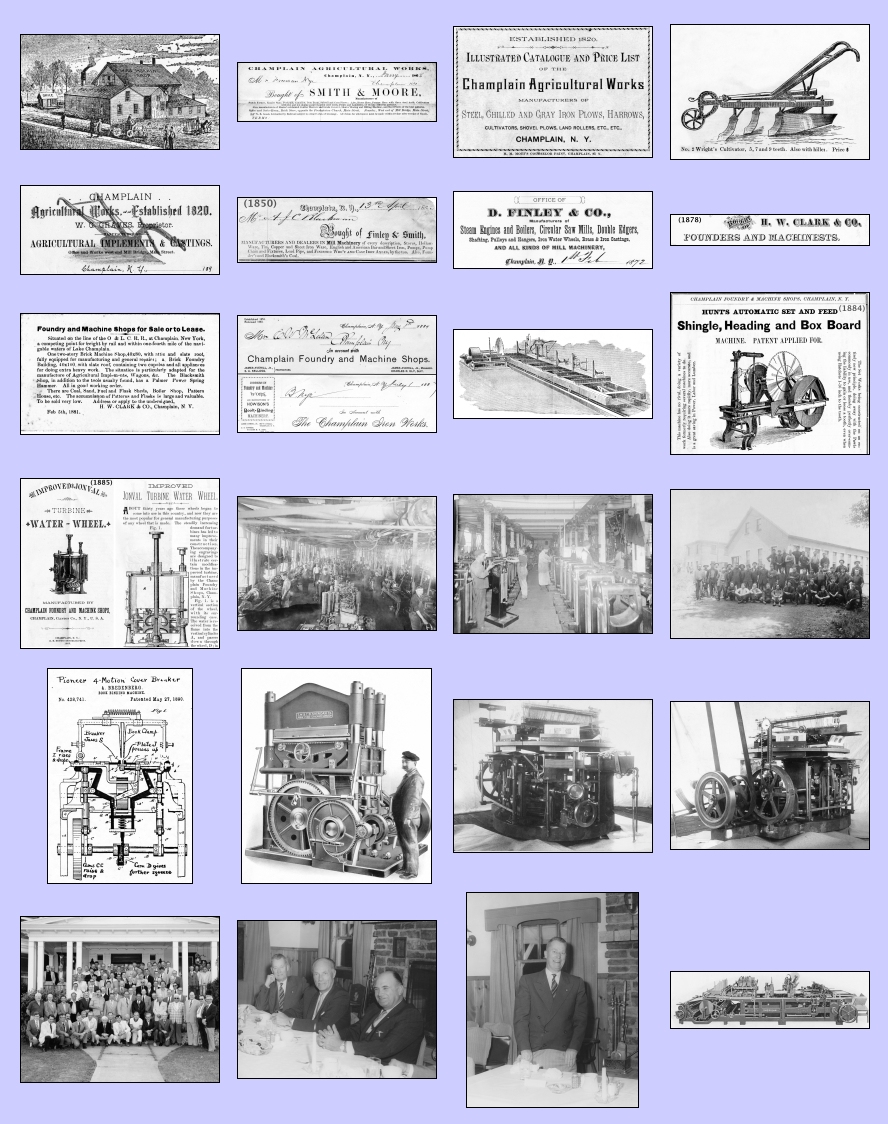
|
|
2015
CHAMPLAIN
HISTORIC CALENDAR
A History of
the Iron Industry in Champlain, New York
from the
Champlain Agricultural Works
to the
Sheridan Iron Works
The Town of
Champlain has always been a major industrial hub in
Clinton County. In its first 100 years since
it was founded by Pliny Moore in 1788, the Great
Chazy River and Corbeau Creek powered dozens of
sawmills, grist mills and flax mills. Between
the 1820s and 1840s, the roots of the iron industry
were planted. At the same time, boat building
commenced along the Great Chazy River.
The most
enduring industry in Champlain was the foundry
business. Two iron foundries were established
in the Village of Champlain - the Champlain
Agricultural Works in 1820 and a small iron foundry
in 1840 that eventually evolved into the Sheridan
Iron Works/Harris Graphics after many ownership and
name changes. The Champlain Agricultural
Works was in existence for about 90 years and the
foundry that became Sheridan was in existence for
almost 150 years. Very few companies in the
United States today can claim a 150 year
existence. This is the story of Champlain’s
enduring foundry businesses.
|
|
|
|
The Champlain Agricultural Works (1820 to
after 1908)
Prior to the 1800s, American and
European farmers used plows made of wood. In
Champlain as well as throughout New York State, the
most popular plow used was the Dutch plow (also
called a hog plow) which was a wooden plow built on
a small cart with two wheels and dragged by horse or
oxen. Wooden plows were good in sandy soils
but would easily break when plowing rocky
soil. The first cast-iron plow was invented in
England in 1789 and improved in the United States by
several people who were issued patents in 1797 and
1807. In 1819, a novel plow design was
invented and patented by a New York man who used
interchangeable parts made of cast-iron. This
design became very popular as it meant a plow could
be repaired easily and cheaply. In 1837, John
Deere invented the first steel plow which was
stronger than cast-iron and did not dull as
easily. The steel was placed at strategic
points on the plow.
The establishment of the iron
industry in Champlain coincides with the invention
and introduction of the cast-iron plow in
town. The first cast-iron plow was introduced
in Champlain in 1820 by James Irvin who employed it
on his farm. This novel plow design caught the
attention of many of Champlain’s farmers who had
arrived from southern New York, Vermont,
Massachusetts and Connecticut between the 1790s and
1810s. After seeing this plow, several
enterprising individuals tried to make similar
plows. Ezra Blasdell cast Champlain’s first
cast-iron plow near Perrys Mills in 1820. That
same year, Noadiah Moore (1788-1859), the oldest son
of Judge Pliny Moore, established the “Champlain
Agricultural Works” in the Village of
Champlain. The foundry initially made
plows, but as the farming industry became more
mechanized, new types of farming implements were
manufactured. The foundry was adjacent to
today’s Main and Cane Streets and situated on the
Great Chazy River. It had an office and sales
room opposite the Presbyterian Church (old village
hall) near the corner of Main and Church
Streets. In 1824, Moore purchased Blasdell’s
small foundry.
In 1819, at the dawn of the iron
industry in Champlain, the Clinton County
Agricultural Society was formed to showcase the
county’s farms, farming tools and produce. On
October 9, 1821, the annual meeting was held in
Champlain with Noadiah Moore as secretary of the
society. The agricultural fair was a perfect
venue to showcase the Agricultural Works’ new plows
and farming equipment which Moore had been making
for only a year.
:
:
:
The Thomas J. Whiteside Foundry
Thomas J. Whiteside was one of
Champlain’s first industrialists. He came to
town in 1807 from Cambridge, New York, and operated
a small store on Main Street in the village of
Champlain called “Price and Whiteside.”
When demand for timber by the steam and canal boat
industry exploded in the 1830s (see the 2014
Champlain Historic Calendar), he built several
sawmills near Perrys Mills and became Champlain’s
largest exporter of timber. In the 1850s the
sawmills were converted to paper mills which were in
operation into the early 1900s and run by his
sons. Operating a sawmill required a lot of
iron and this may have prompted Whiteside in 1840 to
build a small foundry on the south half of lot
number one near the corner of Cedar and Main Streets
(see map) in the Village of Champlain.
The “Finley and Smith” Foundry and the Path
to Sheridan
In 1847, Whiteside decided to
lease his small foundry to David Finley (1812-1881)
and James S. Smith. The first of several
contracts with Finley was signed on September 1,
1847. The establishment of this foundry by
Whiteside in 1840 and the signing of the 1847
contract were the seeds of Champlain’s 148 year old
business that eventually became the Sheridan Iron
Works. Finley incorporated a very large steam
engine at the foundry in 1847, the second ever
brought into town.
:
:
:
D. Finley & Co.
The corporation of “Finley, Smith
& Co.” was short-lived. On April 25, 1856,
James Smith decided to leave the partnership.
He transferred his one-quarter share in the company
to David Finley as well as other property, and in
exchange, Finley gave Smith a large amount of
personal property and lands and assumed all debts
Smith would be responsible for from his interest in
the foundry. The partners signed a new
contract and stated the new company would be called
“D. Finley & Co.” A dividend of 3 percent
was to be distributed to the shareholders when
profits were deemed sufficient and an extra $250 was
to be paid to Finley each year. The contract
also stated that if a dispute arose from this
proposition, John Henry Whiteside would be the
arbitrator and that the two former partners would
abide by his decision. John was the son of
Thomas J. Whiteside and a respected citizen and
businessman in Champlain. James Smith later
went into partnership with Samuel Mattocks Moore’s
Champlain Agricultural Works.
:
:
:
H.W. Clark & Co.
A new foundry company was formed
on September 17, 1872, shortly after David Finley
sold his half of the business. On this date,
Timothy Hoyle, George V. Hoyle, George Hoyle
Burroughs and newcomer Henry W. Clark signed a
contract for the management of the foundry.
The foundry’s partnership terms were similar to the
one signed by Finley in previous years. The
partners agreed that the foundry would continue in
the direction that Finley was taking it and that
they would make the same type of products.
Clark would own one-half of the partnership and
receive $1,000 for his service each year. The
term of the contract would be for five years and
expire in 1877. It also stated the new company
would be called “H. W. Clark & Co.”
Two months after the contract was signed,
shareholder George Hoyle died. His brother
Timothy was executor of his estate and likely
assumed his share of the company. George had
no living children.
:
:
:
Champlain Foundry and Machine Shops and the
Champlain Iron Works
Death would strike yet another
foundry shareholder in 1880. On December 10,
George H. Burroughs died at the age of 35. By
this time Timothy Hoyle was 58 years old and wanted
to exit the foundry business. It was agreed
then that the business of “H. W. Clark & Co.”
would be dissolved and put up for sale. A
printed advertisement dated February 5, 1881 listed
all of the property, buildings and tools that was
owned by the shareholders (the wharf property at the
Rapids was also part of this purchase). An
April 21 advertisement in the local paper by trustee
M.V.B. Stetson noted the death of the founders and
the upcoming sale of the company on May 25. It
is not known what happened at the auction. Two
years would pass before a buyer was found. On
February 14, 1883, the foundry was sold by Timothy
Hoyle to 31 year old James Averill Jr. (1852-1917)
and Champlain lawyer Sylvester Alonzo Kellogg
(1838-1904, his wife was the sister of Averill) for
$5,500 ($135,000 today). The new foundry was
called the “Champlain Foundry and Machine
Shops.”
:
:
:
T.W. & C.B. Sheridan Co. a.k.a. Sheridan
Iron Works
The expansion of the Champlain
foundry’s business into the New York City market
caught the attention of two brothers named Theodore
and Charles Sheridan. James Averill was
looking for more outlets for his book binding
equipment, and coincidentally, the Sheridan brothers
were looking for a location to expand their book
binding manufacturing business. This mutual
interest prompted Averill and Kellogg to sell a
half-interest in the foundry to the Sheridans in
September of 1887. A September 16 article in
the Plattsburgh Sentinel noted the incorporation of
Sheridan in Champlain: “A New Enterprise at
Champlain. / The Sheridan Iron Works, to manufacture
and sell machinery made of iron and wood, and to
carry on a foundry business and machine shop at
Champlain, Clinton county, filed articles of
incorporation in the office of the Secretary of
State on Saturday. The capital is $30,000, and
the trustees: Theodore W. Sheridan, Brooklyn;
Charles R. Sheridan, West Orange; James Averill,
Jr., Champlain, and S. Alonzo Kellogg,
Plattsburgh.” The New York City company was
known as the “T.W. and C.B. Sheridan Co.” The
Sheridans built new buildings and increased the
foundry’s size by 10 times before 1910. The
number of manufactured water wheels, circular saws
and steam engines dwindled as the company focused
its resources on the manufacture of book binding
equipment of all types.
:
:
:
In the early 1890s, a young Swede named Alfred
Bredenberg (1860-1935), of Brooklyn, New York City,
started working for a book binding company founded
by bookbinder and printer Charles W. Lovell
(1855-1931). Surprisingly, Lovell was from
Rouses Point and had been part of his father’s huge
printing and book binding business. His father
was John Lovell who had come to Rouses Point from
Montreal around 1872 to start a printing press
called the Lakeside Press, owned by “John Lovell and
Sons.” John had three sons working for him:
John W., Charles W. and Robert K. John already
had a large printing and publishing house in
Montreal called “Lovell Printing and Publishing
Co.” The newly established press in
Rouses Point did book printing and binding as well
as other types of printing work and was the largest
printing firm north of Albany. John’s son
Charles was in charge of 100 typesetters in a room
of the press. In 1876 Charles married a Rouses
Point lady named Standish and moved to New York City
where he continued in the book binding
business. Charles and his brother John W.
spent their later years in New York City where they
are buried. John W. (1851-1932) had a son
named Fred K. Lovell who moved from New York City to
Rouses Point in 1923 and worked for a brokerage
business. He was also prominent in local
politics and civic activities. His
daughter was Rouses Point resident Jean Lovell
Marleau who died in 2013.
:
:
:
In 1896, Alfred convinced his cousin, Isaac
Bredenberg (1867-1907), also of New York City, to
come to Sheridan and work for him. Isaac moved
to Champlain and became their top erector of
machines. Isaac had a technical education and
graduated from the Royal Technical High School in
Stockholm and was considered a master
mechanic. Unfortunately, he had contracted
tuberculosis before his arrival in Champlain and the
long hours and travel for customers took a toll on
him. He died in 1907 leaving his wife and four
children: Oscar (1893-1970, born in NYC), Henrik
(1895, born in NYC), Mabel (1897, born in Champlain)
and Hulda (1899-1984, born in Champlain).
Isaac’s son Oscar would be the third Bredenberg to
shape Sheridan’s mission during a 49 year career
there.
:
:
:
During World War II, Sheridan’s mission
changed. Instead of only making
bookbinding equipment, the company was retooled to
make presses, stretching machines and sheet metal
benders for use in the aircraft industry. In
1942, a very large manufacturing building, 150 feet
by 250 feet, was added to the west side of the plant
(where Modern Mechanical is now) and the Clark house
was moved across Elm Street to where it is
today. The first stretch press was shipped
that same year to the Edo Aircraft Company.
This company built pontoon planes and floats for
planes to land on in the Pacific Theater which was
badly needed by the troops. The plant also
manufactured presses used to build the Sherman tank
which was the most popular tank used during the
war. The tank was introduced in 1942 and was
made by the Detroit Tank Arsenal and the Fisher Tank
Arsenal in Detroit, MI, as well as by a half-dozen
other companies over the course of the war.
The U.S. Navy also shipped back manufacturing
equipment for refurbishing at Sheridan.
:
:
:
In 1964, Harris-Intertype Corporation of Cleveland,
Ohio, purchased Sheridan. The plant was now
part of the Bindery Systems Division and became
known as Harris Graphics or Harris Bindery.
The plant was still unofficially called
Sheridan as newspaper stories from the 1970’s
indicate. Harris was a worldwide leader in
bookbinding equipment and now the Champlain plant
had access to Harris’ engineering expertise and
worldwide network of sales sites and customers.
In 1979, the Press-Republican newspaper
featured a very informative section devoted to
articles about Champlain’s Harris division. At
the time, the Champlain plant made 60% of the
division’s binder systems.
:
:
:
Each month's
photograph has a detailed history written
about the images below. Many other
images and maps are found in the essay.

Monthly Image
Descriptions
(partial descriptions)
Cover
The Sheridan Iron Works, circa 1909-1910.
This photo was taken by Champlain photographer
B.F. Paine who owned Paine’s Studios on downtown
Main Street in the Village of Champlain.
.
January
This is one of the older photos of the foundry and
shows the original two-story machine shop.
It was probably taken around 1896 along with
several other photographs in this calendar.
February
This photograph was taken at the same time as the
cover photograph. Paine’s car is seen parked
in front of the second machine shop which was
likely built between 1904 and 1911 (based on
several other photographs that are dated).
March
The east and north sides of the original machine
shop is shown.
April
The original brick foundry building is shown,
probably in 1896. The small wooden addition
with the brick chimney was the brass
foundry.
May
This photograph was taken in 1890 and is the
oldest photograph of the Sheridan workers known to
date. It was taken only three years after
T.W. and C.B. Sheridan bought the foundry.
The name key shows the following employees:
George Palmer, Fred Dodds, Th. Lamotte, Pete
Hamel, John Coonan, Fr. Dufresne, John Peat, Tom
Kearney, O’Harra, Ed O’Harra, Alec Dufresne, Mag
Kearney, Mr. Klang, Joe Gamlin, Pat Lafountain,
Alex Chagnon, Mr. Minor, Paul Leware, Albert
Hineth, Paul Babbeau, V. Lafountain, Mr. Miller,
J. Greggory, Jim Powers, M. Cardin, Frank Patnode,
Alex Patnode, William Patrie, Charles Roberts,
Fred Senecal, A. Glode, Pierre LaRivier, Louis
Sanschagrin, George Lambert, Rob Harmon, Pat
Nolan, Mr. McKay, Francis Henry, Mr. Bancroft, Jim
Kearney, Fr. Patnode and Ernest Lambert. The
Samuel de Champlain History Center has the names
key for the photograph that can indentify each
person.
June
This drawing was made by architect Hugh McLellan
who lived in the village of Champlain.
July
The Village of Champlain has always celebrated
July 4th with parades. This photograph was
taken between 1909 and 1911 near the corner of
Main and Elm Streets. The two Nye brick
buildings are shown in the background. The
right building was removed a few years ago but the
left one still stands.
August
The machine shop and brick office building are
shown before the building of the second machine
shop shown on the cover photograph.
September
The first floor of the machine shop shows numerous
tools on the cement shop floor.
October
The second floor of the machine shop shows
additional machines and another long crankshaft
that powered the tools. The second floor had
a wooden floor.
November
This photograph was taken in June of 1893 prior to
the building of the brick office and shows all of
the Sheridan workers. Fortunately, the names
of these men are preserved on the back of the
photograph. They include (in order of their
numbering): Eddy Roberts, Fred Dodds, Ernest
Bancroft, Mr. McClure, Jim Kearney, Tom Murnane,
Tom Kearney, Mr. O’Harra, George Palmer, Pat
Nolan, Mr. Dodds, L. Glode, Louis Sanschagrin,
William Senecal, John Coonan, Glode, Mr. Barron,
Pierre LaRivier, Thomas Lamothe, Fred Patnode,
John Peat, Fred Senecal, Pat Coloumbe, Mr. Fish,
Thomas Senecal, Mr. McKay, Mr. Gregory, Mr.
O’Harra, Fr. Henry, Adelard LaFlamme, George
Glode, George Lambert, Charles Roberts, Pat
Lafountain, Oliver Lafountain, Mr. Eaton, Alex
Dufresne, Mr. Martin and William Jefferson.
The Samuel de Champlain History Center has a names
key for the photograph that can indentify each
person.
December
The Sheridan plant is shown in the late 1950s or
early 1960s. The original 1854 machine shop
and brick office building is present to the left
and is dwarfed by the larger buildings built in
the last 100 years.
|
|

